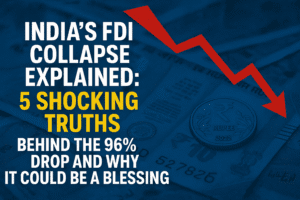India’s FDI Collapse Explained: 5 Shocking Truths Behind the 96% Drop and Why It Could Be a Blessing
India’s net foreign direct investment (FDI) plummeted by 96% to $0.4 billion in FY2024–25, marking a decade-low as repatriation by foreign firms surged and domestic companies expanded overseas investments. However, gross FDI inflows rose 13.7% to $81 billion, reflecting sustained foreign confidence in sectors like manufacturing, energy, and tech. The RBI interprets the outflow spike—foreign exits via IPOs (e.g., Hyundai, Swiggy) and Indian firms investing $29.2 billion abroad—as signs of a maturing economy, enabling seamless capital movement.
Critics warn the net FDI slump risks India’s “China alternative” image, while optimists stress gross inflows reveal long-term trust in India’s growth, despite global investors prioritizing liquidity amid geopolitical uncertainty. The dichotomy underscores a pivotal shift: India is no longer just a destination for foreign capital but a launchpad for its own enterprises going global. While short-term caution persists, structural strengths like demographic dividends and infrastructure growth suggest resilience, turning this FDI paradox into a test of economic evolution over instant metrics.

India’s FDI Collapse Explained: 5 Shocking Truths Behind the 96% Drop and Why It Could Be a Blessing
While headlines scream about a jaw-dropping 96% collapse in India’s net foreign direct investment (FDI) for 2024–25, the story behind the numbers reveals a far more nuanced economic landscape—one where confidence and caution collide. Here’s a breakdown of the forces at play and why experts aren’t hitting the panic button just yet.
The Numbers Behind the Headline
- Net FDI Plunge: Net FDI (inflows minus outflows) cratered to a decadal low of $0.4 billion, down from $10.1 billion the previous year.
- Gross FDI Growth: Gross inflows actually rose 13.7% to $81 billion, signaling sustained foreign interest in sectors like manufacturing, energy, and financial services.
- Outflows Surge: Repatriation by foreign firms hit $51.5 billion (+15%), while Indian companies invested a record $29.2 billion overseas (+75%), led by ventures in Singapore, the U.S., and the UAE.
Repatriation and Outward Investments: Signs of Maturity?
The RBI argues that soaring outflows reflect a maturing economy, not weakness.
- Exit Flexibility: Foreign investors cashing out via IPOs (e.g., Hyundai, Swiggy) or venture capital exits signal a liquid, dynamic market. Healthy economies allow smooth entry and exits.
- Global Ambitions of Indian Firms: Rising outward FDI highlights Indian companies’ confidence to compete globally—a shift from decades of inward-focused growth.
- Market Timing: A booming stock market likely prompted foreign players to lock in profits, redirecting capital amid global uncertainty (e.g., geopolitical tensions, rate hikes).
Expert Opinions: A Divided Landscape
- The Skeptics: Critics warn that dwindling net FDI undermines India’s “China alternative” narrative. A Mumbai fund manager notes, “Global capital has options, and India isn’t the only growth story.”
- The Optimists: Analysts like Rishi Shah (Grant Thornton) see a “FDI paradox”: gross inflows show faith in India’s fundamentals, while net outflows mirror global risk aversion. “This isn’t a rejection of India—it’s institutional investors parking cash during turbulence,” he explains.
- The Pragmatists: The RBI emphasizes sectoral resilience. Manufacturing and renewables continue attracting long-term bets, with Singapore, Mauritius, and the U.S. leading inflows.
Looking Ahead: Cautious Optimism
While the net FDI slump grabs attention, experts urge perspective:
- Short-Term Headwinds: Geopolitical volatility and election cycles may delay investment decisions. Firms await policy clarity post-2024 elections.
- Long-Term Promise: India’s demographic dividend, infrastructure push, and renewable energy transition remain compelling. As Rohit Surana (GoPro Wealth) notes, “Global capital follows stability. Once uncertainty eases, India’s structural strengths will shine.”
- Policy Watch: Streamlining bureaucratic hurdles and enhancing ease of doing business could revive net FDI metrics.
The 96% FDI drop isn’t a red flag but a reflection of India’s complex integration into global capital flows. While short-term caution prevails, the surge in gross investments and Indian firms’ global bets hint at deeper economic maturation. For now, the RBI’s calm stance—viewing exits as a sign of market health—might just be the balanced take this story needs.
In today’s interconnected economy, net FDI figures alone can be misleading. India’s challenge lies in converting transient capital into enduring partnerships—think factories, not stock trades.
You must be logged in to post a comment.